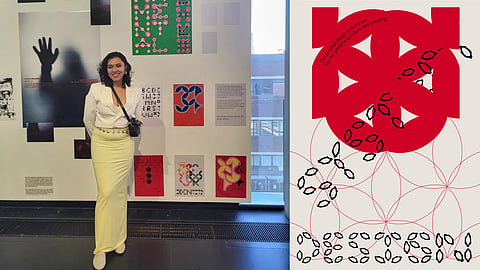
- HOMEGROWN WORLD
- #HGCREATORS
- #HGEXPLORE
- #HGVOICES
- #HGSHOP
- CAREERS
- ABOUT US
- CONTACT US

The following article is centred on Indian designer Sneha Nayak's 'Ornamental Grids', an audacious design project that challenges the dominance of Western sensibilities across creative fields.
The dominance of Euro-centric ideals, principles, and theories has been a stubborn blight on Indian post-colonial society since our emancipation less than a century ago. Whether it's art, fashion, design or even music, as South Asians we find ourselves almost subliminally policing ourselves when it comes to our own culturally rooted influences. We grow up looking outward rather than inward and develop a distaste for any aesthetics that defy the bland minimalism that's become so commonplace globally.
Sneha Nayak is a Manchester-based Indian designer whose practice lies at the crossroads of culture, history, identity, and emotion. Her project, 'Ornamental Grids' is an audacious attempt to spotlight and reframe our perception of South Asian design motifs that are too often pigeonholed into being 'maximalist' or 'excessive', despite the increasingly milquetoast landscape of mainstream design. We sat down with Sneha recently to learn more about what shapes her creative process and the work that went into painstakingly piecing together her latest undertaking.
Tell us a little about this project.
'Ornamental Grids' is a design research project that explores how traditional South Asian ornamental systems, drawn from textiles, architecture, and craft, can be reimagined as contemporary design tools. The project began by questioning why modernist design principles, often rooted in Western minimalism, dominate our education and practice, while ornament is frequently dismissed as “excess/decoration.” By studying and deconstructing historical grids and patterns, I created experimental layouts, posters, and editorial pieces that merge these ornamental systems with modern graphic design methods. The aim is not just to revive traditional practices, but to show how they can operate as living design systems that are capable of carrying cultural memory, inspiring new forms, and challenging the boundaries of what design can look like today.
Describe your creative process and the purpose with which you create.
My process typically begins with research, particularly delving into cultural archives, texts, or overlooked forms. From there, I start gathering references, then deconstructing and reinterpreting them visually through the core elements of design, including grids, typography, and motifs. The purpose is always to create work that acts as a bridge, helping people see cultural continuity, challenge dominant design norms, and spark new conversations around identity and inclusivity.
What are some of your biggest inspirations and influences over the course of your artistic career so far?
History, folklore, and the stories we’ve grown up with have always been huge influences on me. Even everyday things that we often overlook like patterns on a wall, a phrase in conversation, or a detail in architecture, they spark ideas that I try to transform into something special. Beyond that, theories like intercultural transfer (the exchange of cultural elements between distinctly different traditions that give birth to something new) have really shaped my practice during my MA. I find these ideas powerful because they’re inherently inclusive; they show how cultures are constantly in dialogue, and how design can bring people closer together, which feels especially important in today’s world.
I’ve always been drawn to cultural forms that carry stories within them like folk patterns, architecture, textiles, and typography. Beyond that, history and philosophy are huge inspirations, because they shape how societies express themselves visually. Artists and studios who experiment with form and narrative, like those working at the intersection of design and anthropology, also inspire me to push my work beyond surface-level aesthetics.
What are some things you learned while putting this project together?
One of the biggest things I realised is that design has always been political. No matter how much I tried to avoid conversations around race, cultural appropriation, or Western dominance, they kept surfacing as central to my research. The design education we receive in India, and even the sensibility we’re trained to value, is deeply rooted in modernism and therefore very Western in its outlook. But alongside this, I also see a shift, independent artists and designers digging into our own cultural nuances, traditions, and visual histories to create work that feels authentic and truly represents us. That tension between what we’ve inherited and what we’re reclaiming is something I constantly grappled with while working on this project. I myself struggled a lot to step out of the modernist design frameworks I was taught while working on this project.
Who are some artists who are currently on your radar?
One of them is Loes van Esch & Simone Trum from Team Thursday, a Rotterdam-based graphic design studio. They search for and document patterns from everyday life, translating them into adaptable graphic forms. Another is Dr. Martin Lorenz, a designer, researcher, and author of 'Flexible Visual Systems'. I also really look up to Kimaya Gandhi, a Typeface Designer of Indic letterforms and a design Educator
Tell us about a project you wish you were a part of.
I wish I could be part of Decolonising Design, the collective co-founded by Danah Abdulla and Ahmed Ansari. It’s not a single project but a growing movement where critical design researchers, artists, and activists come together at the intersection of feminism, politics, and design. Their work resonates with me because it challenges the dominant, Eurocentric narratives of design and instead opens space for plural voices, cultures, and methods of making. Being part of a community that actively questions power structures in design, while imagining more inclusive and equitable futures, is something I deeply align with and would love to contribute to.
If you enjoyed reading this here's more from Homegrown:
In 'Myth, Memory, Meaning' Four Indian Women Artists Explore The Politics Of The 'Self'
Jahnavi Sharma's Zine Centres Women's 'Drawers' As A Site Of Intimacy & Ritual
Easter Eggs, Cats, & Honest Women: The Playfully Wild Wonder Of Saakshi Sankhe's Art
